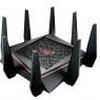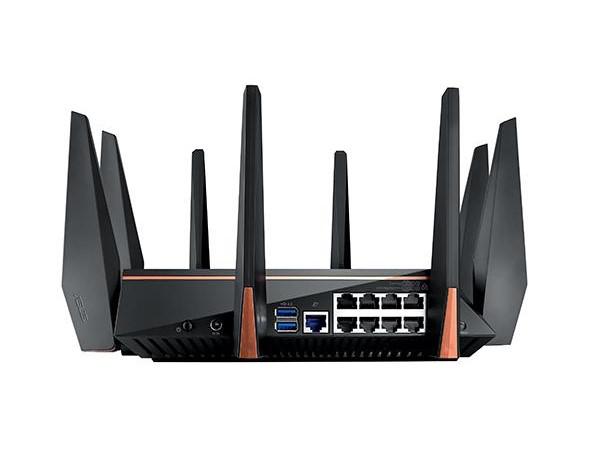The ASUS Rapture GT-AC5300 gaming went on sale a week or so ago, the flagship ASUS 802.11ac Gaming Router offers network prioritizing and really is a small computer all by itself.
The GT-5300 looks exactly the same as the RT-AC5300 that came out some two years ago. It also shares the same Wi-Fi standard as its older sibling. Both are tri-band routers with two 5-gigahertz bands, each with a top speed of 2,167Mbps. A third 2.4GHz band tops out at 1,000Mbps. The router supports MU-MIMO, allowing it to support devices on multiple Wi-Fi tiers without slowing any of them down.
The Rapture consists of four processors, 1GB of RAM, and 512MB of storage. The CPUs are similar to those of the Raspberry Pi 2 and Raspberry Pi 3. Software and TCP/IP processing is handled by the new Broadcom BCM4908, a 64-bit chip with quad Cortex-A53 cores running at 1.8GHz. Supplementing the primary processor are three Broadcom BCM4366E CPUs, one for each of the Rapture’s 802.11ac wireless bands. All three contain a 32-bit Cortex-A7 running at 800MHz and are responsible for the hardware I/O processing for their respective wireless bands. That I/O processing allows each 5GHz band to achieve a peak link rate of up to 2167Mbps. The link rate doesn't have a one-to-one relationship with throughput, but a higher rate will provide better bandwidth. Meanwhile, the 2.4GHz band can hit up to 1000Mbps.
Our ASUSWRT firmware brings a bevy of features that utilize the Rapture’s additional processing power, including static routing, TCP/UDP port filtering, traffic shaping, VPN hosts and clients, and deep packet inspection.
The Rapture has two Gigabit Ethernet switches, each with four connections. The ports on the left side, closest to the WAN jack, are labeled LAN 1, 2, 5, and 6, and have some special magic built into them. LAN 5 and 6 combine to do link aggregation (802.3ad), which means a server connected to the Rapture via 802.3ad can access 2Gbps of full-duplex bandwidth. Many NAS devices these days have the requisite dual NICs and software support to take advantage of this feature. LAN 1 and 2 are the gaming ports, and they have primacy over all traffic delivered to the switch. These ports give users a hardware method for ensuring top priority for gaming machines that's separate from any other traffic management efforts.
Though billed as a Gamers Private Network, GPN is simply a fancy name for a VPN. Traffic is routed to your ISP, then to WTFast, and then to your game server in an attempt to shorten the total path and reduce latency. You can test the impact using Game Radar, the Rapture's integrated gaming latency test. The interface provides a drop-down menu that lists major games; pick your title, and Game Radar pings each of the game's major data centers across the globe.
The router can be spotted in the 400~450 USD ranges and is available as we speak. Tip - the Asus RT-AC88U or the RT-AC5300 will deliver the same experience for less money.



